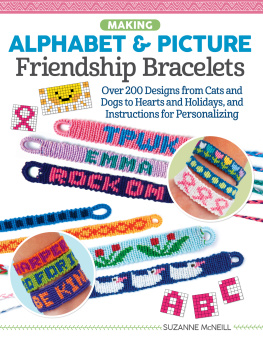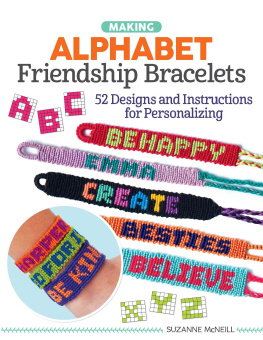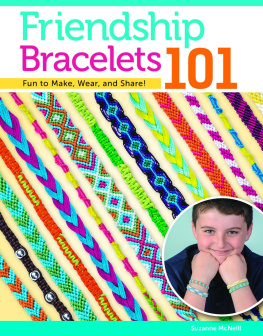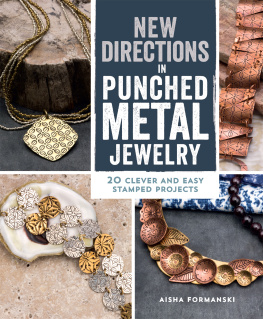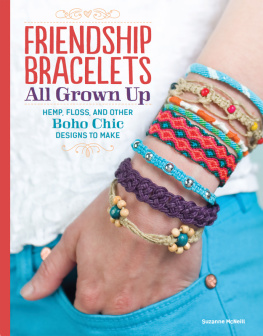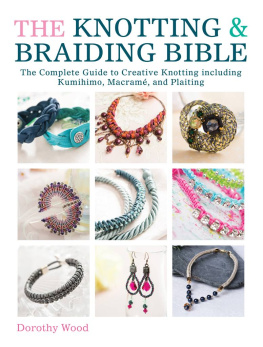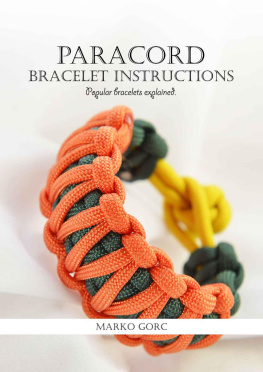CHARM LOVE FRIENDSHIP BRACELETS
35 UNIQUE DESIGNS WITH POLYMER CLAY, MACRAM, KNOTTING, AND BRAIDING
Sherri Haab

Acknowledgments
Thank you to my editor, Joy Aquilino, for her encouragement and support; to Zac Williams, for the beautiful photos; and to the staff at Quarto Publishing Group USA for producing a beautiful book.
2015 by Quarry Books
Text and project designs 2015 Sherri Haab
Photography 2015 Quarry Books
First published in the United States of America in 2015 by
QUARRY BOOKS, a member of
Quarto Publishing Group USA Inc.
100 Cummings Center, Suite 406-L, Beverly, Massachusetts 01915-6101
Telephone: (978) 282-9590 | Fax: (978) 283-2742
www.quarrybooks.com
Visit www.craftside.net for a behind-the-scenes peek at our crafty world!
All rights reserved. No part of this book may be reproduced in any form without written permission of the copyright owners. All images in this book have been reproduced with the knowledge and prior consent of the artists concerned, and no responsibility is accepted by the producer, publisher, or printer for any infringement of copyright or otherwise, arising from the contents of this publication. Every effort has been made to ensure that credits accurately comply with information supplied. We apologize for any inaccuracies that may have occurred and will resolve inaccurate or missing information in a subsequent reprinting of the book.
10 9 8 7 6 5 4 3 2 1
Digital edition: 978-1-62788-320-7
Softcover edition: 978-1-63159-043-6
Digital edition published in 2015
LIBRARY OF CONGRESS CATALOGING-IN-PUBLICATION DATA
Haab, Sherri.
Charm love friendship bracelets : 35 unique designs with polymer clay, macrame, knotting, and braiding / Sherri Haab.
pages cm
ISBN 978-1-63159-043-6 (paperback) ISBN 978-1-62788-320-7 (digital edition)
1. Charm bracelets. 2. Ropework. 3. Polymer clay craft. I. Title.
TT840.R66H33 2015
739.278dc23
2014049090
Design: Laura Shaw Design, Inc., lshawdesign.com
Cover Image: Zac Williams, Williams Visual. Inc. | Photography: Zac Williams, Williams Visual, Inc.
Technical Illustrations: Rebecca Chung
To my husband Dan, for his love and patience all these years. To my children, Rachel, Michelle, and David, for their support and creative inspiration.
Contents
Preface
For as long as I can remember, Ive been making small jewelry objects with clay. Im in my element with clay and always have been. The first piece of jewelry I made was a pendant using Play-Doh clay when I was about six years old. I remember waiting days for the clay to dry so I could wear it. Through my teen years and into adulthood I enjoyed working with all kinds of sculpting materials, including bread dough, papier-mch, ceramic, and pottery clay.
After discovering polymer clay, my world changed in many ways. My sister and I wrote one of the first widely distributed books on the subject, which became the catalyst that launched my career as a craft and jewelry-making book author.
Its no wonder that polymer clay is so popular. It doesnt dry out until you cure it with heat, its easy to manipulate, and there are more techniques than you can imagine. Its a perfect medium for jewelry making, as it can take on many forms and textures. It can be fashioned to make a piece thats whimsical and full of color, or it can be made to look very sophisticated and muted like a natural stone. I truly believe that polymer clay is the most versatile material out there for crafting jewelry. Plus, you dont need special equipment or skills to make a successful piece.
After writing many jewelry-making books on various topics over the years, with most containing a lot of clay projects, it occurred to me that all of these books shared another common themeeach contained at least one project featuring knotting in one form or another. Projects included macram, crochet, and needlework techniques. Just like my clay obsession, my love of threadwork extends back to my childhood. As a child, I remember making a beaded ring by following a pattern I had retrieved from a box of seed beads a neighbor had given to me. After threading tiny seed beads row by row according to the diagram, I became so excited to see the pattern began to emerge. Another project from the early 1970s was inspired by a ring my mother had made by crocheting metallic elastic thread and embedding a cluster of pearl beads on top. I was thrilled when she taught me how to make one of my own, and I proudly wore this treasured keepsake to elementary school. Since then, Ive always been drawn to fiber jewelry and have enjoyed working with knotting techniques.
One day when I was yearning to work with polymer clay again, the thought occurred to me: why not write a book combining two of my favorite mediumsclay and thread! The more I thought about it, the more excited I became. The two mediums felt compatible to me, and it seemed only natural that there should be an entire book dedicated to the idea. In my mind, there were so many ways you could combine them with unlimited design possibilities. Ideas started pouring in.
Clay and thread go perfectly well together for many reasons. One of my favorite observations is that both mediums present color as a dynamic artistic expression. Thread and cord are available in every color imaginable. Polymer clay can be mixed to match or coordinate with any chosen thread or cord color. There are also clay and thread variations that provide similar reflective qualities. For example, metallic threads are paired with a painted clay centerpiece in the Silver Threads project on . Not only do the colors match, but the silver paint and metallic threads both reflect light, delivering a subtle shimmer.
The compatibility of clay and thread makes it easy to pair clay designs or styles with meaningful knot patterns. Take, for example, Sweet Bee on . For this design, I selected a golden yellow thread and used an alternating knotted pattern characteristic of a beehive or a honeycomb pattern to go with a vintage bee illustration.
A knotted pattern can enhance a polymer clay design to interpret a style. For example, think of a geometric bead paired with a sleek monochromatic braided cord versus a sculptured clay rose bead threaded on a multiknotted wrap bracelet design with lots of color and texture. One idea is minimalistic and modern, whereas the other has a handmade, carefree playfulness to it.
In addition to pairing style and color, clay and thread have similar tactile and weight qualities. Delicate clay pieces can be made to balance a delicate thread pattern. Sculpting your own beads allows you to control the scale and weight of a design rather than relying on what is available with purchased beads.
With so many options, there is lots of room for creativity. The projects in this book vary in material and style, so you will be sure to find something that speaks to you and is fun to make. A quick trip to the craft supply store and you will find everything you need to get started. Enjoy the projects!
CHAPTER ONE
POLYMER CLAY ESSENTIALS


